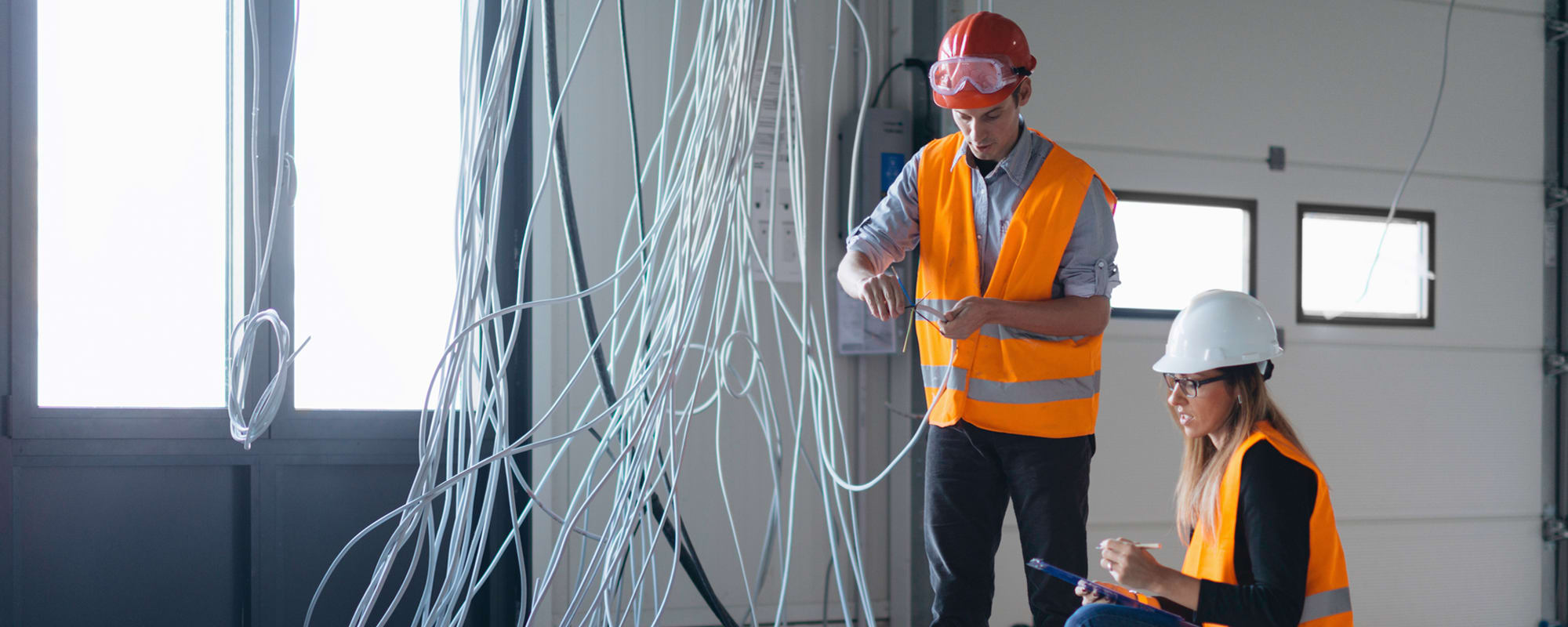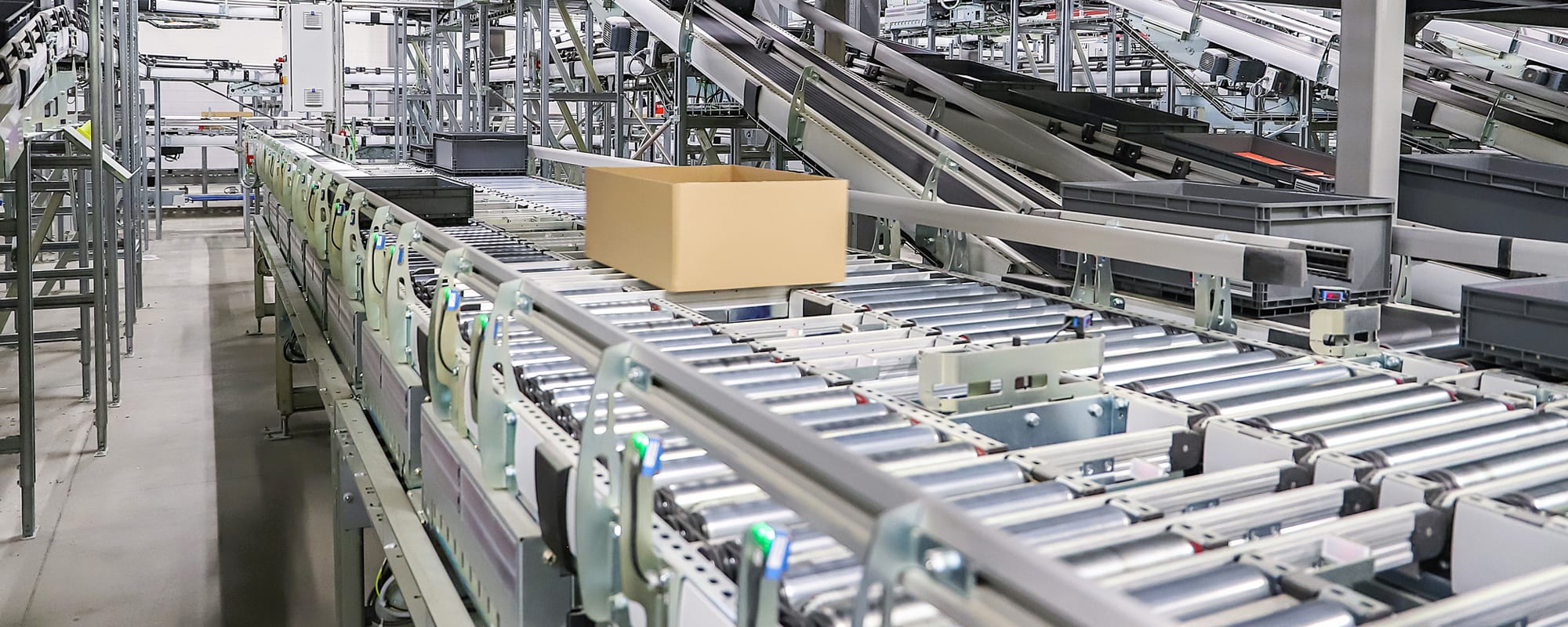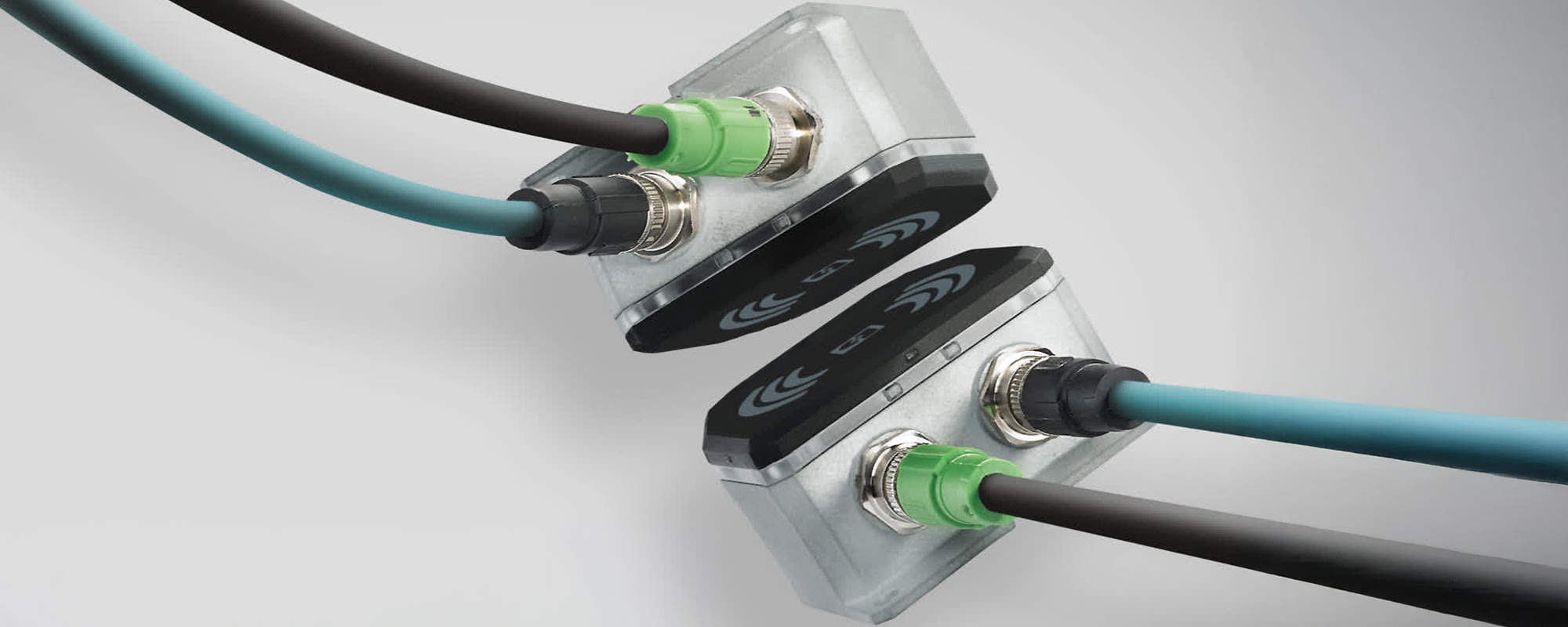Cables are an essential component of every electrical and electronic technology in our increasingly interconnected world, so ensuring that they remain securely connected is key to preventing unplanned downtime, equipment damage, safety hazards, and production and profit losses. Shawn Whittaker, Group Products Manager at Panduit, explains how cable entry systems outperform cable glands and introduces several Panduit solutions sure to simplify your workloads and save you time and money.
Shawn Whittaker, Group Products Manager, Panduit

Cables and connectors are used to transmit power, signal, and/or data in electronic equipment, including wireless solutions, which still have to be plugged into a power source at some point. Without cables and connectors, there would be no electronic systems and devices. And as various segments of the electronics industry continue to adopt Industry 4.0 trends, including electrification, the massive volume of cabling that supports every electronic process continues to grow.
As such, cable management solutions are also an essential element of electronic systems. Cable management solutions include products designed to identify, organize, protect, secure, and support electrical cables, such as cable markers, tie mounts, wiring duct, and cable entry solutions.
Cable Entry Solutions
Cable glands — which are also often referred to as cord grips, strain reliefs, fittings, and even connectors depending on what part of the U.S. or the world you’re in — and cable entry systems help ensure that the cables essential to applications utilized throughout the industrial manufacturing, energy, utilities, marine, and railway industries — including electrical enclosures, control panels, and machines — remain connected to help prevent unplanned downtime, equipment damage, safety hazards, and production and profit losses. They also supporting the safe and secure routing of hydraulic and pneumatic hoses.
Standard cable entry solutions:
- Seal enclosures, control panels, and machinery against hazards including dirt, dust, debris, moisture, chemicals, and lubricants.
- Prevent loosened cable connections and inadvertent disconnections.
- Protect cables from stress and damage.
- Provide strain relief for the connection and equipment circuitry to mitigate wear.
- Afford an appropriate level of resistance for adequate tension or holding force.
Specialized solutions can also be used to:
- Establish safe connection points that protect against sparks and arc flashes.
- Provide earth grounding when metal cord grips are used with armored cables.
- Prevent flammable substances, such as gasses, from entering equipment enclosures in hazardous environments.
Cable Glands

Cable glands are generally comprised of three or four components: two gland halves, a grommet, and — for variants designed to resist water ingress or pressure — an elastomer seal. The primary exception is split cable glands, which are designed for routing terminated vs. unterminated cables and, as such, are comprised of the same three components split into connectable halves for a total of six component parts that are still capable of offering environmental protection ratings up to IP66 and NEMA 4X.
The front half of a cable gland, which is often called a cap nut or dome cap, secures the gland to the enclosure, control panel, bulkhead, or machine you’re mounting the cable to. The grommet, which is situated between the two halves, seals and locks the cable into place, and the back half of the cable gland, often called the thread, holds the cable gland together.
These components are available in a variety of plastic and metal materials designed to withstand the rigors of various environments, including stainless steel, aluminum, and brass, and are generally used for cables with diameters extending from 1–75mm.
Cable Entry Systems

Cable entry systems, which are also occasionally referred to as gland plates or cable entry plates, were introduced in the 1990s to provide a cost-effective alternative to heavy-duty industrial connectors and cable glands as the prevalence of electrical and electronic cables grew. Like cable glands, cable entry systems are used to provide safe, organized entry into industrial enclosures, machines, and electrical equipment, as well as standard and specialized benefits including integrated strain relief and ingress protection. However, unlike cable glands, which are each designed to accommodate a single cable, cable entry systems enable the routing of several to dozens of cables with different diameters, which makes them quicker, easier, and less costly to install, and significantly shrinks space requirements.
Cable glands require installers to position, drill a hole for, and assemble each component individually, and the vast majority of them only accommodate unterminated cables. High-density cable entry systems require a single opening, which significantly reduces installation space requirements, time, and costs, and are widely available in variants designed to accommodate both terminated and unterminated cables. Cable entry systems can also provide extra openings in the same design to accommodate future cabling additions and changes and support scalability. And these unique advantages continue to become even more impactful as cable volumes in various segments of the electronics industry continue to multiply.
Cable entry systems are typically available with rectangular or round frames made of plastic or metal materials. Cable entry systems designed for unterminated cables are equipped with polymer or elastomer membranes that allow users to simply push cables through the ports. Cable entry systems designed for terminated cables and complete cable harnesses feature split-entry sealing grommets typically made of elastomer and, like split cable glands, offer a range of environmental protection ratings up to IP66 and NEMA 4X — just quicker and more easily.

Both variants are also widely available with UL recognition and are widely used in applications with rigorous hygiene requirements, including those in the food and beverage and pharmaceutical manufacturing industries. Applications with rigorous hygiene requirements and unterminated cables and tend to use membrane-based cable entry systems over hygienic stainless steel cable glands since the smooth membrane surfaces are devoid of dirt- and bacteria-collecting recesses and are widely available in FDA-compliant materials. Applications with terminated cables and rigorous hygiene requirements tend to use hygienic stainless steel frames and sealing grommets made of FDA-compliant materials.
Panduit Cable Entry Systems
Panduit cable entry systems provide users with safe, efficient, well-organized, user-friendly, and cost-effective solutions for passing both terminated and unterminated cables and hoses through enclosures, control panels, and machines while supplying adequate strain relief and maintaining IP and NEMA sealing ratings.
Traditional cable glands require several time-consuming installation steps and considerable installation space. Panduit cable entry systems, on the other hand, allow you knock out your control panel organization with just one punch rather than one punch per cable. They also simplify your panel designs, provide significant time, space, and cost savings, and support scalability and design flexibility.

With Panduit cable entry systems, you can enjoy:
- Increased Efficiency – Our solutions are compatible with industry-standard electrical cutout punch tools, have their imperial dimensions physically molded directly into them, and have high-density hole configurations capable of accommodating up to 12 terminated cables or 140 unterminated cables with a single punch.
- Substantial Time, Space, and Cost Savings – Our high-density designs require up to 80% less space and 80% less installation time than cable glands in applications with multiple cables, which conserves limited space, dramatically increases productivity, frees installers up for other activities, and offers the lowest total installed cost compared to traditional cable glands, making them an efficient cable gland alternative.
- Design Flexibility – Unlike most cable glands, which are overwhelmingly designed to handle unterminated cables, Panduit cable entry systems make it quick and easy to handle both terminated and unterminated cables, which prevents the often warranty-voiding re-termination of cables and further boosts productivity. They’re also available in both round and rectangular geometries with plastic or metallic frames, a variety of high-density port configuration options, and extra hole locations that support future cabling changes and additions, and they accommodate a wide range of cable diameters extending from 0.06” up to 1.18”.
- Proven Cable and Sealing Protection – Our sealing membranes and grommets provide integrated strain relief to prevent cables from over-bending at cable entry points, prohibit friction, and are available with IP and NEMA environmental protection ratings up to IP66 and NEMA 4X to accommodate a variety of indoor application requirements.
Panduit’s CEST1 and CEST2 round and rectangular cable entry systems are available in a variety of configurations with 1–12 openings and utilize small, medium, and large CEG grommets designed to accommodate cables spanning 0.08–1.18” in diameter to achieve IP54, IP66, and NEMA 1, 12, and 4X sealing properties. The screw-mount frames are made of UV-resistant, UL94 V-0 polypropylene and thermoplastic elastomer (TPE) or polyamide 6 material, incorporate integrated strain relief, and are rated for operating temperatures extending from -30°C to +100°C. The CEG grommets are made of UV-resistant, UL94 V-0 TPE materials with the same operating temperature ratings as the CEST1 and CEST2 frames and are available in variants designed to accommodate zero, one, two, or four cables and compatible with AS-Interface (ASi) cable as well as with PLT2S-C0 cable ties designed to secure cables within the grommets.

Panduit’s CESU2 rectangular cable entry systems for unterminated cables are available in a variety of different configurations made of UV-resistant, UL94 HB polyamide 6.6, thermoplastic polyurethane (TPU), and ethylene-propylene diene monomer (EPDM) materials or aluminum and stainless steel plates.
The plastic versions are equipped with 10–29 openings ranging from 3.0–20.1mm (0.12–0.79”), designed for snap-in fastening or screw mounting, equipped with an identification area suitable for a printed label, and rated for operating temperatures extending from -30°C to +70°C. Their ports feature an innovative polymer membrane that provides a high-quality fit around cables, a high degree of strain relief, and an IP65 seal.
The metal versions are ideal for high-density cabling applications in demanding environments and feature UV-resistant, UL94 HB seals made of nitrile butadiene rubber (NBR) and EPDM materials rated for IP65, NEMA 1, and NEMA 12 protection and operating temperatures extending from -30°C to +90°C. Aluminum versions are available in three configurations with 8–47 openings spanning 3.0–27.9mm (0.12–1.1”) and require user-supplied screws and nuts for mounting. Stainless steel versions are available in two configurations: one with 47 openings spanning 3.6–16.0mm (0.14–0.63”) and one with 140 openings spanning 3.6–24.9mm (0.14–0.98”) and are equipped with integrated fasteners and ideal for use in food and beverage, pharmaceutical, and chemical manufacturing applications.

Round CESU2 cable entry systems for unterminated cables are available in a range of configurations made from UL94 HB polyamide 6.6, NBR, and EPDM materials, designed for snap-in fastening or securing in place with a locknut, and equipped with 4–46 openings spanning 3–16mm (0.12–0.63”). They’re rated for operating temperatures extending from -30°C to +90°C, offer IP65, NEMA 1, and NEMA 12 sealing, and, like the rectangular versions, deliver a high degree of strain relief.
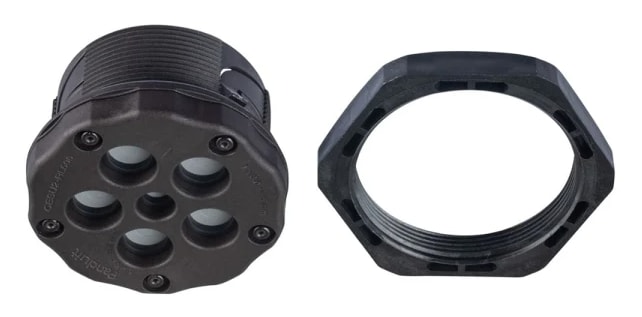
Panduit’s CESUM3 rectangular cable membrane plates for unterminated cables are available in a variety of configurations made of UV-resistant, UL94 HB polypropylene frames and TPE seals, equipped with 10–24 openings ranging from 3–20mm (0.12–0.79”), and designed for screw mounting. They offer quality strain relief, IP66, NEMA 12, and NEMA 4X sealing, and are also rated for operating temperatures spanning -30°C to +70°C.
Round CESUM3 cable membrane plates for unterminated cables are largely the same but are designed for snap-in fastening or screwing in place with a locknut and only available in two configurations: one with six openings spanning 2–12mm (0.08 – 0.47”) and one with seven openings spanning 3–9mm (0.12–0.35”).
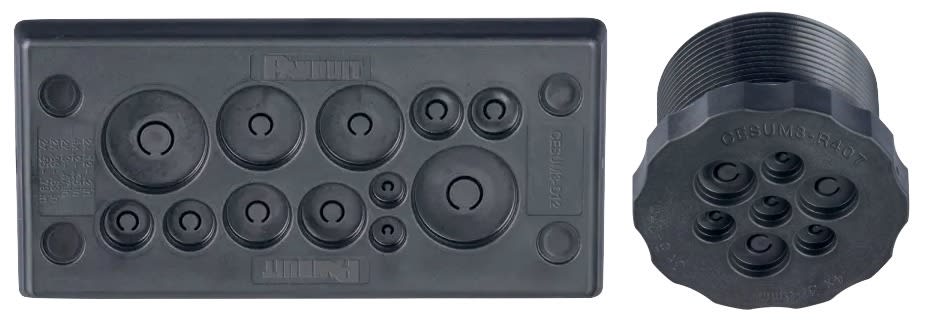
Simplify Your Cabling Workloads With Panduit and RS
Panduit designs and manufactures a robust portfolio of strategic network infrastructure and industrial electrical wiring solutions optimized for our increasingly interconnected world, engineered to help customers in a variety of industries overcome challenges and achieve success, and backed by more than 60 years of experience.
Panduit also offers a robust global network of authorized distributors capable of providing local inventory as well as expert product support and logistics services. RS supports our Americas customers with an extensive selection of Panduit’s physical infrastructure products, including cable management and identification solutions, cable assemblies, connectors, enclosures, cabinet and rack components, electronic components, tools and hardware, test and measurement solutions, and facility cleaning and maintenance products.
For more information about these solutions or Panduit’s portfolio of cable entry systems engineered to ensure that cables essential to industrial manufacturing, energy, utilities, marine, and railway applications — including electrical enclosures, control panels, and machines — remain well organized, secure, and connected, please visit the links embedded here. For assistance identifying, procuring, deploying, and maintaining Panduit cable entry systems sure to satisfy your unique application demands and improve your workloads, please contact your local RS representative at 1.866.433.5722 or reach out to the RS technical support team.
